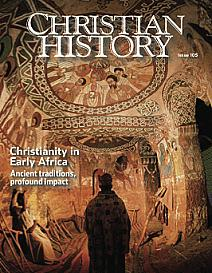EGYPTIAN CHURCH WAS FOUNDED BY MARK THE GOSPEL WRITER

[Mark with Paul, by Durer. John LaFarge. Great Masters. New York: McClure Phillips co. 1903. Public domain.]
A YOUNG MAN named John Mark resided with his mother Mary in Jerusalem. She was well-to-do. We know this because Christians gathered in her large home and she had at least one servant girl. The apostle Peter knew the place: When an angel released him from prison one night, he headed to Mary’s house. There he informed Jerusalem’s Christians of his escape and hurried away to hide (Acts 12:5–19).
The Bible mentions John Mark several times. He had a cousin, Barnabas, a Levite. When the church at Antioch commissioned Paul and Barnabas to carry the gospel into Asia Minor, Mark accompanied them as long as they hugged the coast. But he deserted them when they turned inland. (Acts 13:5,13) Later, Barnabas wanted to take Mark along on a second trip, but Paul balked. The two quarreled and separated—one of two incidents in which Paul and Barnabas disagreed with each other. (The other had to do with eating with Gentiles. Galatians 2:13.) Barnabas took Mark to Cyprus while Paul partnered with Silas (Acts 15:36–40). Over time, Paul’s breach with Mark healed. In two of his last letters, Paul mentioned Mark as a coworker (Philemon 1:24; 2 Timothy 4:11).
Peter also mentioned a Mark whom he described as his “son” (1 Peter 5:13). This would suggest he had mentored him in the faith. Early Christians said this Mark was the same as John Mark. As Peter would have known John Mark from his visits to Mary’s home, the identification is likely. Mark is said to have served as a translator to Peter in Rome (“Babylon” 1 Peter 5:13) and wrote down Peter’s account of the life of Christ. This has come to us as the Gospel According to Mark.
Although the Gospel of Mark nowhere identifies its author, the church has connected it with his name at least since the second century. Because most of Mark’s content appears in the Gospels of Matthew and Luke, some think Mark compiled his work from theirs. Modern critics put Mark’s account first and say the other two worked from his short account. A big difference is that Mark did not report Jesus’s sermons in depth.
What was Mark doing during the years between his appearances in the pages of the Bible? A strong African tradition says that because he was born in Cyrene (a city in modern Libya he returned to North Africa to plant churches and to found the see of Alexandria. There he infuriated pagans who dragged him through the city at the end of a rope, killing him.
Jerome gave his death as 25 April 62 (the sixth year of Nero). This is the date followed by the Vetus martyrologium romanum. But Jerome may have mistaken Mark’s temporary departure from Alexandria for the time of his death. In the last letter Paul wrote, around AD 67, he asked Timothy to bring John Mark (2 Timothy 4:11.) He would not have done so if Mark had already been dead for five years. A stronger tradition places Mark’s death on this day, 26 April 68.
As with many Bible figures, we can only conjecture Mark’s life and dates from a few clues and traditions. Mark’s story encourages us, however, because after a rocky start, he became a faithful and reliable witness for Jesus. His Gospel has blessed the entire world.
—Dan Graves
----- ----- -----
For more on the emergence and place of the African church, read Christian History #105, Christianity in Early Africa






